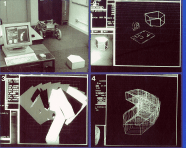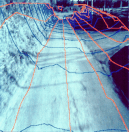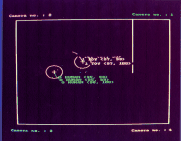Autonomous vehicles (AVs) are used to perform routine tasks for industry, as well as being used in areas hazardous to humans. Machine vision can provide such vehicles with 'sight', allowing them to understand their surroundings and leading to more flexible use of AVs.
 Stereo vision enables AVs to have a 3-dimensional (3D) understanding of
their environment (Fig 1). This can be used to perform free space
mapping (FSM). FSM allows an AV to find clear paths between obstacles.
Firstly the ground plane (GP) is identified by fitting a plane through
objects lying in it, e.g. floor markings. Edge detection identifies
features in the AV's field of vision (Fig 2). Edges that are not in the
GP are assumed to belong to objects that extend to the GP, and thus
would obstruct the AV's movements (Fig 3). This approach enables 3D
objects to be distinguished from features like floor markings.
Three-dimensional scene edges, derived using stereovision, can also be
used for vehicle navigation, and for the location and tracking of known
objects (Fig 4).
Stereo vision enables AVs to have a 3-dimensional (3D) understanding of
their environment (Fig 1). This can be used to perform free space
mapping (FSM). FSM allows an AV to find clear paths between obstacles.
Firstly the ground plane (GP) is identified by fitting a plane through
objects lying in it, e.g. floor markings. Edge detection identifies
features in the AV's field of vision (Fig 2). Edges that are not in the
GP are assumed to belong to objects that extend to the GP, and thus
would obstruct the AV's movements (Fig 3). This approach enables 3D
objects to be distinguished from features like floor markings.
Three-dimensional scene edges, derived using stereovision, can also be
used for vehicle navigation, and for the location and tracking of known
objects (Fig 4). If an autonomous guided vehicle (AGV) enters an unknown area, it must be
able to understand its surroundings, as it proceeds. One approach to
achieving this, involves analysing the images received from a camera
placed at the front of the AGV. Firstly, features such as corners
(T-junctions or Y-junctions) are located as the AGV moves through the
scene. Such features are chosen, because the point of intersection of
the lines which form a corner is fixed regardless of the angle from
which it is viewed. The features identified are then tracked in the
series of images. As the AGV moves, the apparent motion of features in
its field of view will depend on their distance. In fact from the
trajectories of features in the image, their 3D positions, and the 3D
motion of the AGV, can be estimated. By superimposing a Cartesian grid
on the image (see Fig ), a driveable region can be defined.
If an autonomous guided vehicle (AGV) enters an unknown area, it must be
able to understand its surroundings, as it proceeds. One approach to
achieving this, involves analysing the images received from a camera
placed at the front of the AGV. Firstly, features such as corners
(T-junctions or Y-junctions) are located as the AGV moves through the
scene. Such features are chosen, because the point of intersection of
the lines which form a corner is fixed regardless of the angle from
which it is viewed. The features identified are then tracked in the
series of images. As the AGV moves, the apparent motion of features in
its field of view will depend on their distance. In fact from the
trajectories of features in the image, their 3D positions, and the 3D
motion of the AGV, can be estimated. By superimposing a Cartesian grid
on the image (see Fig ), a driveable region can be defined. AVs have mechanisms to locate their position relative to their
environment. Correct calculation of the AV's position is essential for
safe and effective performance of tasks. It is therefore necessary to
monitor the movements of an AV and correlate this information with the
AV's own estimate of its position. One such sytem uses four fixed
cameras to survey a workspace. The image from each camera is used to
identify objects by subtracting the received image from a reference
image of the empty workspace. The positions of the cameras are
calibrated so that the positions of the objects on the floor can be
determined from their positions in the image. The data from the four
cameras is fused to achieve precise location. Objects, such as people,
can be distinguished from an AV by using models which describe
characteristic features.
AVs have mechanisms to locate their position relative to their
environment. Correct calculation of the AV's position is essential for
safe and effective performance of tasks. It is therefore necessary to
monitor the movements of an AV and correlate this information with the
AV's own estimate of its position. One such sytem uses four fixed
cameras to survey a workspace. The image from each camera is used to
identify objects by subtracting the received image from a reference
image of the empty workspace. The positions of the cameras are
calibrated so that the positions of the objects on the floor can be
determined from their positions in the image. The data from the four
cameras is fused to achieve precise location. Objects, such as people,
can be distinguished from an AV by using models which describe
characteristic features.